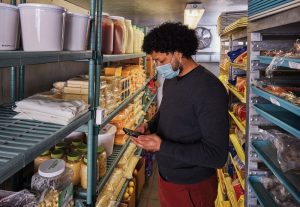— By Manik Suri —
Food waste is a major issue. Here’s what you can do about it.
What do Dutch Bro’s, Eggs Up Grill, and Domino’s have in common? They are creating more sustainable businesses by replacing manual temperature checks with automated systems.

Manik Suri, Therma
Project Drawdown found that about a third of food produced is never eaten, which means that the resources used to grow that food is wasted. This waste of resources is ultimately accountable for 8% of global carbon emissions. But food waste isn’t just a climate issue — it has real financial ramifications for restaurants.
The average restaurant spends about 33% of its revenue on inventory, and throwing out food before it gets to patrons’ plates reduces a location’s profitability. This article will explain how restaurant food waste happens, and what can be done about it.
The Impact of Food Waste in Restaurants
Across the cold chain and within restaurants, inadequate cold storage and manual temperature checks are the primary drivers of food waste. Restaurant staff are trained to record temperature on paper for health compliance, but this manual record doesn’t provide insight into vital information about equipment health. When emergency equipment breakdowns occur, restaurants then have to throw out entire coolers’ worth of inventory.
 To understand how much food restaurants waste, Therma° partnered with Impactable X, a leading third-party firm that quantifies social impact. The goal was to learn how much restaurants could reduce their carbon footprint through introducing automated temperature monitoring and alerts. We found that restaurants can save an average of 3,960 lbs of food per location, per year — roughly 35 weeks of food for a family of 4.
To understand how much food restaurants waste, Therma° partnered with Impactable X, a leading third-party firm that quantifies social impact. The goal was to learn how much restaurants could reduce their carbon footprint through introducing automated temperature monitoring and alerts. We found that restaurants can save an average of 3,960 lbs of food per location, per year — roughly 35 weeks of food for a family of 4.
What is Remote Temperature Monitoring?
Automated temperature monitoring has emerged to enable operators to understand their equipment performance, take corrective action on findings, and prevent food waste. Sensors complete automatic temperature checks every 10 minutes, and the software reads that data to create analytics that helps operators make critical decisions. The main components of temperature monitoring systems consist of:
- Sensors that measure temperature and humidity of equipment.
- A hub or connected gateway that processes sensor temperature data and sends it to the cloud.
- Software that interprets and displays the sensor data, turning it into usable information such as temperature alerts and temperature logs.
We’ve been able to drive change in our customers’ businesses by streamlining operations, alerting teams of equipment failures and prevent loss events. Here are three customer stories that demonstrate how:
How Alerts Prevented Food Waste at Eggs Up Grill
After deployment, an Eggs Up Grill franchise owner, Mark Cotone, received an automated alert that a cooler temperature was steadily climbing. Because the temperature rise was relatively slow, the restaurant employees did not immediately recognize the problem. However, subsequent warnings that the temperature was continuing to climb urged the owner to direct his staff to relocate the food from the cooler and repair it. Automated temperature alerts ultimately saved his inventory of fresh and pre-prepped foods from a spoilage event.
“Another ROI driver is the labor costs for re-prepping food that had to get thrown out due to spoilage,” says Cotone.
Providing Visibility During Off-Hours for Domino’s
As director of operations for 12 Domino’s Pizza franchise locations in Colorado, Bill Oliver works to reduce the carbon footprint of his stores and streamline operations. After installing our remote monitoring device in his store, Oliver uncovered problems that he had worried about but couldn’t prove previously.
“We were able to prove to our overnight vendors that their delivery personnel had been leaving the door open too long when bringing product in, compromising the product and wasting energy,” says Oliver.
After adjusting vendor practices, Oliver saw a significant decrease in energy use month over month.
Supporting Dutch Bro’s Through Extreme Weather Events
During extreme heat waves, refrigeration systems are pushed to their limit. While Dutch Bro’s frozen drinks are a welcome reprieve from hot weather, that same weather presents unique problems for their operations.
“Once it gets up to about 115° to 120°, our refrigeration and HVAC equipment starts to fail. That’s just thermodynamics,” notes Drew Rees, facilities manager of Dutch Bro’s.
Since installing Therma° in its locations, Dutch Bro’s have prevented loss events due to equipment failure. For example, in one recent episode in Arizona, Rees was alerted to a sharp temperature spike in one of their walk-in fridges. Upon receiving a second alert, Rees promptly called a maintenance worker who could go onsite and fix the equipment within 2 hours. This swift action prevented a massive food loss event.
Saving Money by Cutting Food Waste
Remote temperature monitoring presents a solution to the restaurant industry’s food waste problem. By eliminating last-minute equipment emergencies, restaurants can save 3,960 lbs of food per location, per year, from the trash. These savings ultimately drive more profitable locations and create more sustainable businesses.
— Manik Suri is the founder and CEO of Therma, a technology company that builds safety and sustainability tools to eliminate food waste, energy inefficiency and refrigerant emissions to protect consumers and combat climate change. Therma is deployed across major restaurant chains including McDonald’s, Taco Bell and more.

